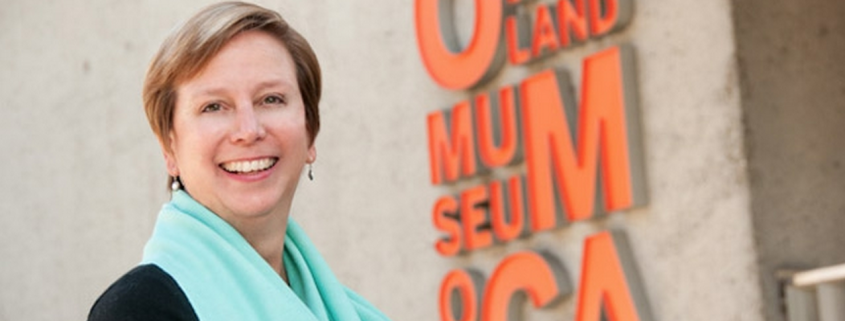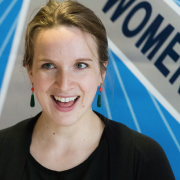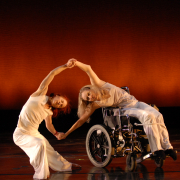Executive Director Roadmap: Insights into OCMA’s Lori Fogarty
Executive Director, Lori Fogarty, is leading Oakland Museum of California (OMCA) in groundbreaking transformation of its’ art, history, and natural sciences collections. With more than twenty years of the museum experience Fogarty previously served as director of the Bay Area Discovery Museum in Sausalito, where she oversaw a successful $19.5 million capital campaign and expansion project. She also spent twelve years at SFMOMA in multiple positions including senior deputy director, deputy director of Curatorial Affairs, and associate director of development. Fogarty graduated summa cum laude and Phi Beta Kappa from Occidental College in Los Angeles in 1984. In addition to her professional background, she has served on the boards of Enterprise for High School Students, the Children’s Day School in San Francisco, and the Association of Children’s Museums. She is currently on the board of Head-Royce School.
Lori was interviewed by Jessie Dykstra, East Bay Fund for Artists Coordinator at The East Bay Community Foundation and a 2013-14 EAP Fellow.
JD: What experiences that happened along the way helped get you to where you are today?
LF: I definitely think some of it was luck. Every institution that I’ve joined – the Music Center, SFMOMA, Bay Area Discovery Museum, and then the Oakland Museum of California – was at a real moment of inflection, of change and growth. I first started at SFMOMA when it was in the old building on Van Ness Avenue. But we knew a new facility was on the horizon with a Capital Campaign in the near-term, and that institution grew and transformed so much during the period I was there. So I think I have had incredible good luck to be with institutions that were on a growth trajectory.
Early in my career, I also had really fantastic bosses and mentors that I learned so much from. And then I think you just have to do a really good job. You have to work really hard, you have to prove yourself, and you have to be a positive asset no matter where you are in the organization – I started out as an administrative assistant!
But within these institutional roles, I would put myself forward. I remember an important moment at SFMOMA when I was still in Development and we were starting a strategic planning process. I raised my hand and said I was happy to help coordinate it – above and beyond my job – and that really positioned me for a next step. You have to keep your eyes open for those opportunities, so that even within an institution – and certainly when opportunities come to take the next step with another organization – you are brave enough to go after those opportunities. So I would take some credit for hard work, but a lot of good fortune, too.
JD: What pieces of advice would you give someone who wanted to move to a director level one day?
LF: Again, I think you have to look for opportunities to play a leadership role, at any level. I’m a huge believer that there are people within the middle management level of every organization that really make a difference. And they usually, show a great attitude. I recently read about the idea of being “emotionally expensive”; there are people within organizations that are a real drain on the culture and morale – they’re high maintenance. It’s very rare that those people get into leadership because they’re not advancing the goals of the organization. So I think you have to show that you’re not just there for your own career or individual function, but demonstrate every day that you’re committed to the organization as a whole.
Honestly, as a former English major, I think communication skills are really critical. People who are good writers and present themselves well in a public setting – those fundamentals go a long way. Yes, graduate degrees and experience can be important, but I think “soft skills” around communication, demonstrating leadership, being a positive catalyst for morale and organizational culture – those are the things that, for the staff I supervise, make all the difference.
JD: Looking back at all of those building experiences, what do you think has prepared you best for the job you have now?
LF: The people I’ve worked with have prepared me well – both on the staff and board. This may sound silly, but I was writing a thank-you note this morning to someone who had opened their home for a donor event, and it made me remember back to early in my career at SFMOMA. The Director of the Museum went to great lengths to make personal touches; etiquette was really important to him. Those little details make a difference, especially in fundraising and relationship-building. That was a really important model to have at an early stage in my career, and there were many other people I was able to observe who really excelled in their positions.
I would say that being in a Director role involves such a diverse set of tasks, responsibilities and skills. For example, take financial and budgeting oversight. Early in my career I would have thought, “I don’t know how to do that – I was terrible in math! I was an English major!” But I do a lot of that now, and a lot of fundraising; personnel management is also a huge part of the job. I think you have to be very ready, knowing that it’s going to be all of that. There will some parts of the job that you’re comfortable with, and some parts that you’re not. So you have to work hard at the parts that are new and seek out experience and exposure where you may not have had it before.
I also look to colleagues at other institutions. I try to keep a strong network of other museum directors and have always remained very close to the organizations I’ve left. I continue to turn to colleagues that I haven’t worked with for 15 years and ask: Do you have a job description for this? Do you know anybody who would be good at that? I think you need to look very deliberately within your network for what you can learn.
JD: For those significant changes that have happened in the museum, how have you personally, in your leadership role, managed those very big changes?
LF: Well, there were hard moments! I think back to a few years ago when I read the book Game Change, which told the story of the 2008 presidential campaigns. Something that was a revelation to me was reading that one of the big advantages of the Obama campaign was that he had a really solid team that was on the same page, with shared goals and values. Within the Clinton campaign, there were huge egos and people with tons of experience, but a lot of in-fighting. So one of the things I’ve learned in going through these huge changes is that you do not do it alone. No director or leader can go through it single-handedly – the idea of “heroic leadership” is outdated. Instead you have to find really good people to work with who you trust– people who can be brave and make tough decisions with you. And through that, you really create a sense of team.
So one of the things I’ve learned in going through these huge changes is that you do not do it alone. No director or leader can go through it single-handedly – the idea of “heroic leadership” is outdated. Instead you have to find really good people to work with who you trust– people who can be brave and make tough decisions with you. And through that, you really create a sense of team.
When we were going through the gallery renovation, I brought in people who were very bold and helped me face what we needed to do. With the transition in our operations from the city, I hired a consultant to be my partner through the whole process, and also brought in the senior staff and said, “We’re doing this together, and I need everyone’s best thinking.” And that’s the leadership culture I’ve tried to build, in that the six members of the executive team aren’t only looking at their specific function and trying to be an advocate for their own department, but they are sharing in the leadership of the institution. They are accountable for doing what’s best for the museum as a whole. Sometimes the challenge for me is having the desire to make everybody feel good and make everything okay– kind of the “good mom” complex. But you can’t do that. You have to build leadership from all levels of the organization, as we were talking about earlier, and then create a team that really works as a team.
JD: Let’s close by talking about what you would like to leave as your legacy, whether with this institution or more generally. What would you consider to be “success” for yourself?
LF: I would start with two things. On the organizational level, I’d like to have left every organization I’ve worked for better for my having been there – to have taken OMCA to the next level. And if I can help the Oakland Museum to claim a truly vital, trusted role as a resource for this community, particularly the very local community, that would be what I would consider success.
For the field at large, I hope the Museum can serve as a model, that people could say that we are an example of a museum that truly is connected to its community. And I’d like to see us go much further on that path.
More personally, I try really hard to be a good mentor to people. I want the people I work with to feel valued and respected – that this is a good, healthy place to work. And for the people who are serious and really committed to growing in their careers, I hope I can be a help and inspiration for them, like many people have been for me in my career.
And in all of that, I hope I can stay sane and healthy myself! I have two kids, and when I thought about what has prepared me best for my role as a director, I thought of parenthood. There have been many lessons learned on the job – in both areas. And I think being a parent has provided some enforced balance for me. I could do this job 24 hours, 7 days a week – but I have to go home and be Mom. The year we were going through the transition with the city was also my son’s senior year of high school, and I remember leaving really challenging negotiations with the city and then going on a college visit. And it was really hard on one hand, but on the other hand it gave me perspective. So I also hope that my family will stay safe and sane through this journey, too.
##
Jessie Dykstra is the coordinator of the East Bay Fund for Artists at the East Bay Community Foundation. She is also responsible for managing the Foundation’s scholarship programs and supporting the grants administration process. Before joining the Foundation Jessie was an institutional fundraising consultant with Quinn Associates, an arts management consultancy serving small and mid-sized organizations in the Bay Area. She previously held positions in Development at The Wooden Floor and the California Institute of Integral Studies. Jessie is a candidate in the MBA program at the Lokey Graduate School of Business at Mills College.
Executive Director Roadmap: Insights into OCMA’s Lori Fogarty is part of the series The Heart of It: Stories from Leaders in the Bay Area Arts Community, an EAP MADE Project. Learn more about the series by visiting the MADE page in our website.








Leave a Reply
Want to join the discussion?Feel free to contribute!